CHCCSM005: Develop, Facilitate, and Review Case Management Assessment
VerifiedAdded on 2020/09/17
|54
|14956
|123
Homework Assignment
AI Summary
This document is a completed assessment book for the CHCCSM005 unit, focusing on developing, facilitating, and reviewing all aspects of case management. It addresses key components like counselling, coordinating, and advocacy functions, along with the client's role in assessment, planning, and implementation. The assessment explores the importance of considering family dynamics, holistic client issues, and relevant laws and regulations. It also covers strategies for identifying local resources and facilitating client participation, including the application of behavior change models. The assignment includes responses to various questions, demonstrating an understanding of case management principles, client engagement, and the stages of change model. This assessment aims to evaluate the student's knowledge and ability to apply case management concepts effectively, ensuring competence in the unit.
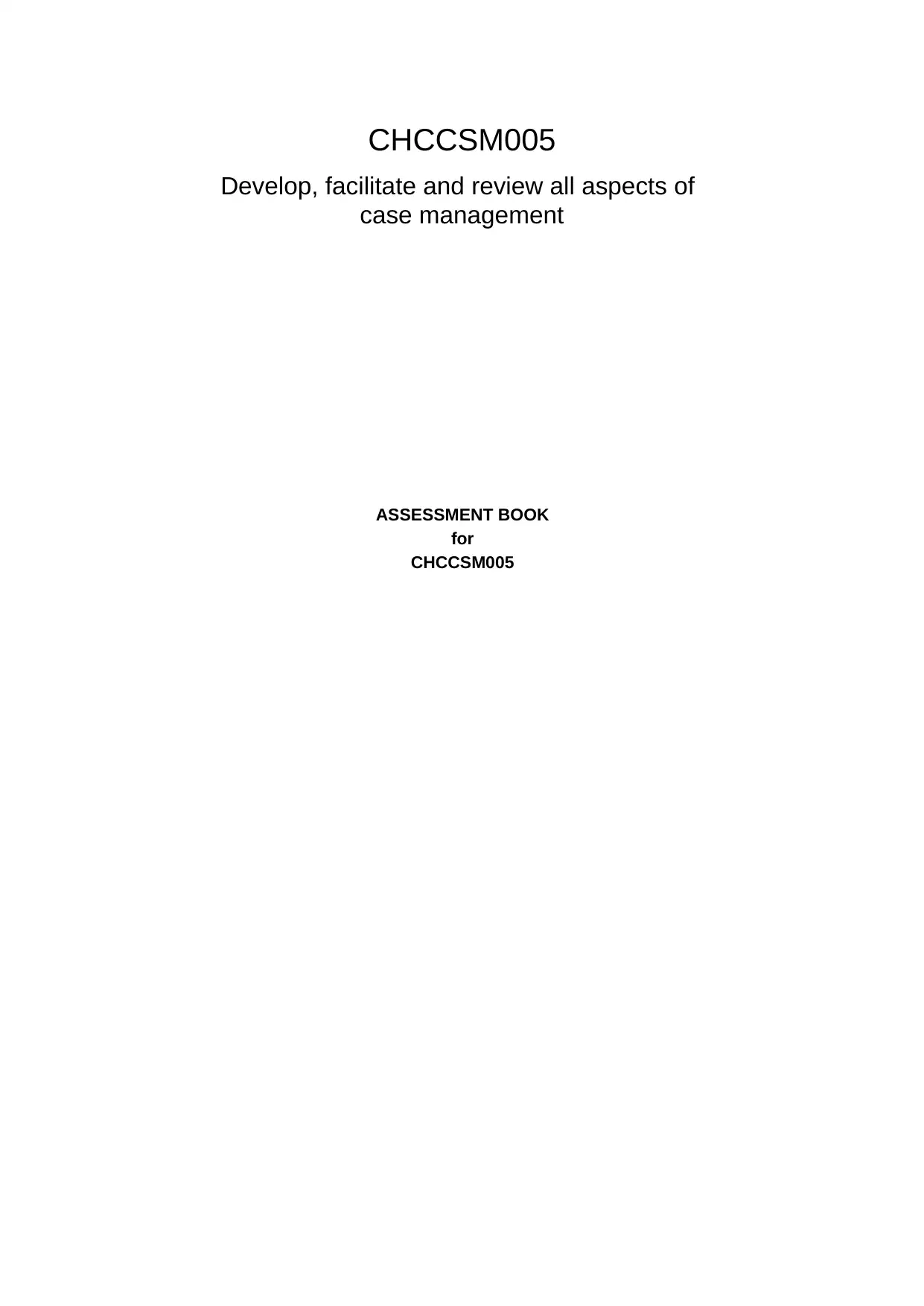
CHCCSM005
Develop, facilitate and review all aspects of
case management
ASSESSMENT BOOK
for
CHCCSM005
Develop, facilitate and review all aspects of
case management
ASSESSMENT BOOK
for
CHCCSM005
Paraphrase This Document
Need a fresh take? Get an instant paraphrase of this document with our AI Paraphraser

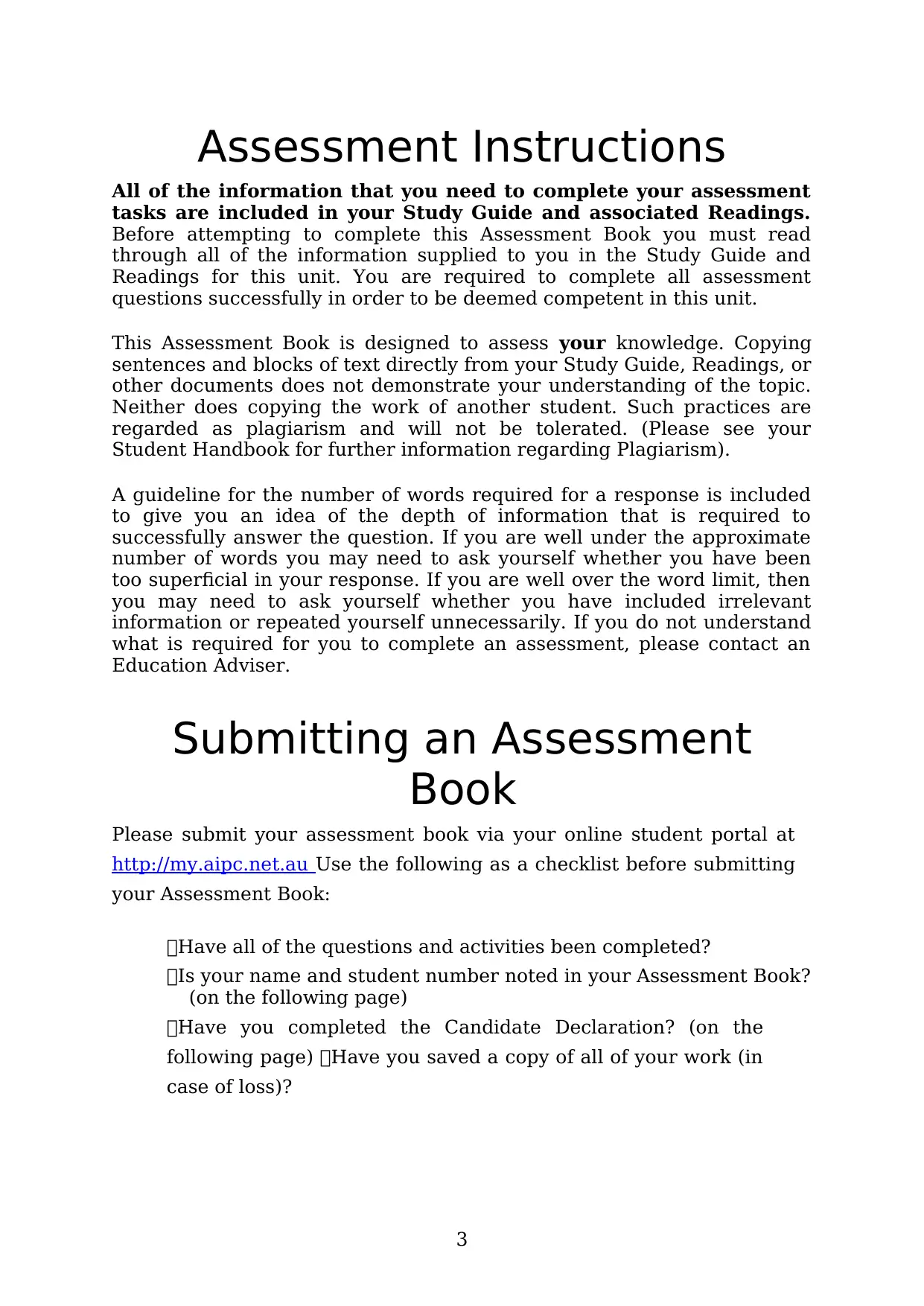
Assessment Instructions
All of the information that you need to complete your assessment
tasks are included in your Study Guide and associated Readings.
Before attempting to complete this Assessment Book you must read
through all of the information supplied to you in the Study Guide and
Readings for this unit. You are required to complete all assessment
questions successfully in order to be deemed competent in this unit.
This Assessment Book is designed to assess your knowledge. Copying
sentences and blocks of text directly from your Study Guide, Readings, or
other documents does not demonstrate your understanding of the topic.
Neither does copying the work of another student. Such practices are
regarded as plagiarism and will not be tolerated. (Please see your
Student Handbook for further information regarding Plagiarism).
A guideline for the number of words required for a response is included
to give you an idea of the depth of information that is required to
successfully answer the question. If you are well under the approximate
number of words you may need to ask yourself whether you have been
too superficial in your response. If you are well over the word limit, then
you may need to ask yourself whether you have included irrelevant
information or repeated yourself unnecessarily. If you do not understand
what is required for you to complete an assessment, please contact an
Education Adviser.
Submitting an Assessment
Book
Please submit your assessment book via your online student portal at
http://my.aipc.net.au Use the following as a checklist before submitting
your Assessment Book:
Have all of the questions and activities been completed?
Is your name and student number noted in your Assessment Book?
(on the following page)
Have you completed the Candidate Declaration? (on the
following page) Have you saved a copy of all of your work (in
case of loss)?
3
All of the information that you need to complete your assessment
tasks are included in your Study Guide and associated Readings.
Before attempting to complete this Assessment Book you must read
through all of the information supplied to you in the Study Guide and
Readings for this unit. You are required to complete all assessment
questions successfully in order to be deemed competent in this unit.
This Assessment Book is designed to assess your knowledge. Copying
sentences and blocks of text directly from your Study Guide, Readings, or
other documents does not demonstrate your understanding of the topic.
Neither does copying the work of another student. Such practices are
regarded as plagiarism and will not be tolerated. (Please see your
Student Handbook for further information regarding Plagiarism).
A guideline for the number of words required for a response is included
to give you an idea of the depth of information that is required to
successfully answer the question. If you are well under the approximate
number of words you may need to ask yourself whether you have been
too superficial in your response. If you are well over the word limit, then
you may need to ask yourself whether you have included irrelevant
information or repeated yourself unnecessarily. If you do not understand
what is required for you to complete an assessment, please contact an
Education Adviser.
Submitting an Assessment
Book
Please submit your assessment book via your online student portal at
http://my.aipc.net.au Use the following as a checklist before submitting
your Assessment Book:
Have all of the questions and activities been completed?
Is your name and student number noted in your Assessment Book?
(on the following page)
Have you completed the Candidate Declaration? (on the
following page) Have you saved a copy of all of your work (in
case of loss)?
3
⊘ This is a preview!⊘
Do you want full access?
Subscribe today to unlock all pages.

Trusted by 1+ million students worldwide
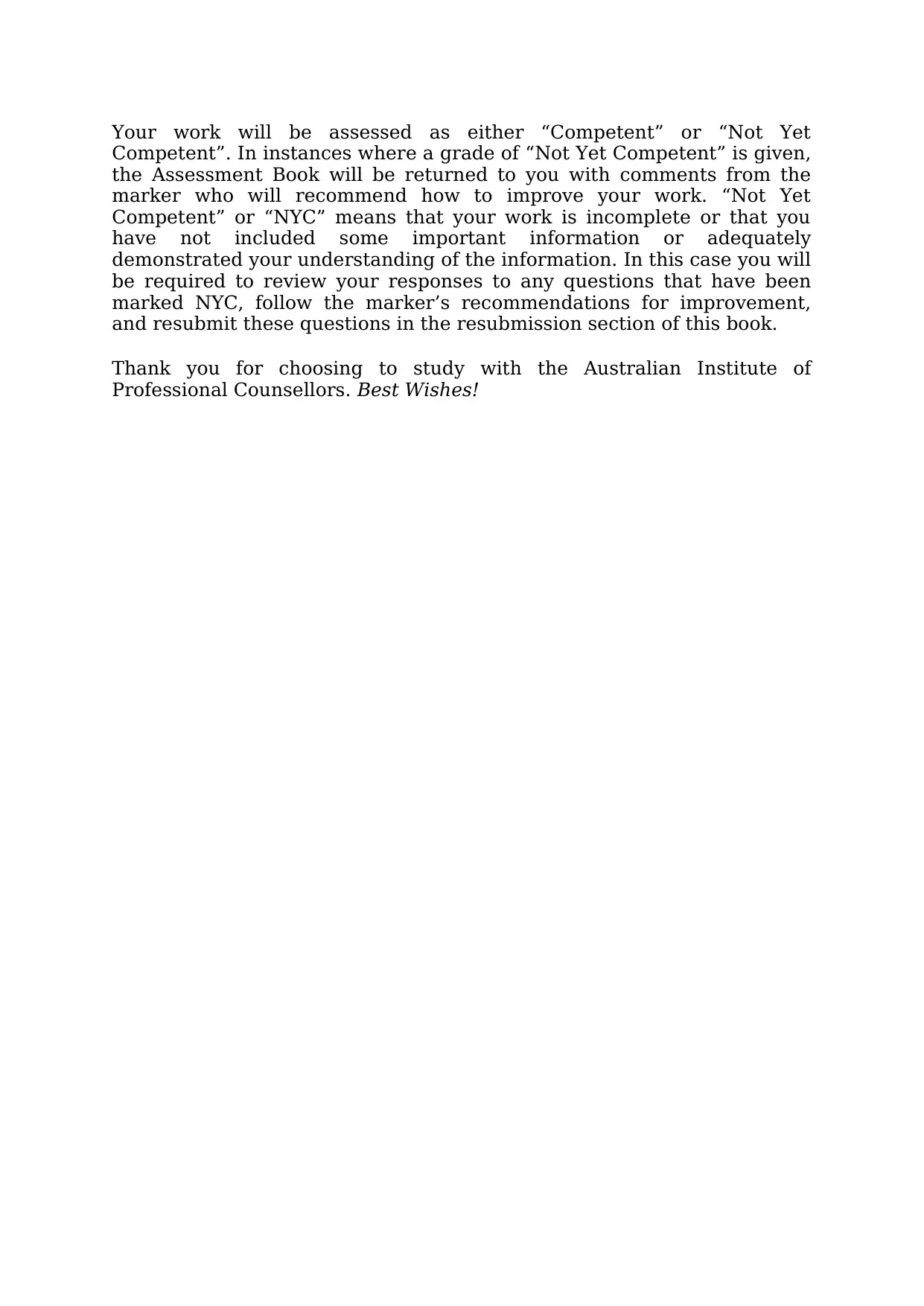
Your work will be assessed as either “Competent” or “Not Yet
Competent”. In instances where a grade of “Not Yet Competent” is given,
the Assessment Book will be returned to you with comments from the
marker who will recommend how to improve your work. “Not Yet
Competent” or “NYC” means that your work is incomplete or that you
have not included some important information or adequately
demonstrated your understanding of the information. In this case you will
be required to review your responses to any questions that have been
marked NYC, follow the marker’s recommendations for improvement,
and resubmit these questions in the resubmission section of this book.
Thank you for choosing to study with the Australian Institute of
Professional Counsellors. Best Wishes!
Competent”. In instances where a grade of “Not Yet Competent” is given,
the Assessment Book will be returned to you with comments from the
marker who will recommend how to improve your work. “Not Yet
Competent” or “NYC” means that your work is incomplete or that you
have not included some important information or adequately
demonstrated your understanding of the information. In this case you will
be required to review your responses to any questions that have been
marked NYC, follow the marker’s recommendations for improvement,
and resubmit these questions in the resubmission section of this book.
Thank you for choosing to study with the Australian Institute of
Professional Counsellors. Best Wishes!
Paraphrase This Document
Need a fresh take? Get an instant paraphrase of this document with our AI Paraphraser
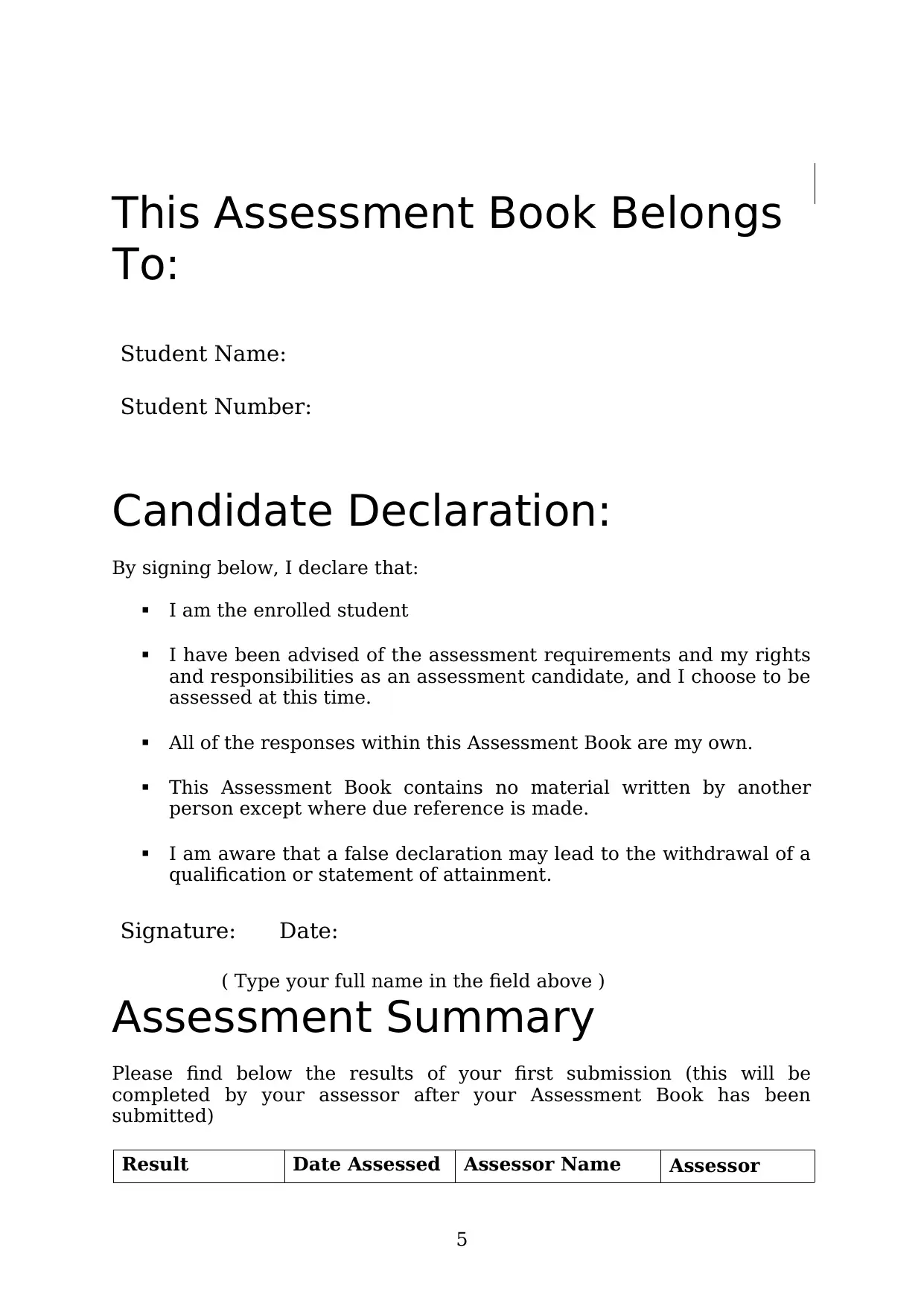
This Assessment Book Belongs
To:
Student Name:
Student Number:
Candidate Declaration:
By signing below, I declare that:
I am the enrolled student
I have been advised of the assessment requirements and my rights
and responsibilities as an assessment candidate, and I choose to be
assessed at this time.
All of the responses within this Assessment Book are my own.
This Assessment Book contains no material written by another
person except where due reference is made.
I am aware that a false declaration may lead to the withdrawal of a
qualification or statement of attainment.
Signature: Date:
( Type your full name in the field above )
Assessment Summary
Please find below the results of your first submission (this will be
completed by your assessor after your Assessment Book has been
submitted)
Result Date Assessed Assessor Name Assessor
5
To:
Student Name:
Student Number:
Candidate Declaration:
By signing below, I declare that:
I am the enrolled student
I have been advised of the assessment requirements and my rights
and responsibilities as an assessment candidate, and I choose to be
assessed at this time.
All of the responses within this Assessment Book are my own.
This Assessment Book contains no material written by another
person except where due reference is made.
I am aware that a false declaration may lead to the withdrawal of a
qualification or statement of attainment.
Signature: Date:
( Type your full name in the field above )
Assessment Summary
Please find below the results of your first submission (this will be
completed by your assessor after your Assessment Book has been
submitted)
Result Date Assessed Assessor Name Assessor
5
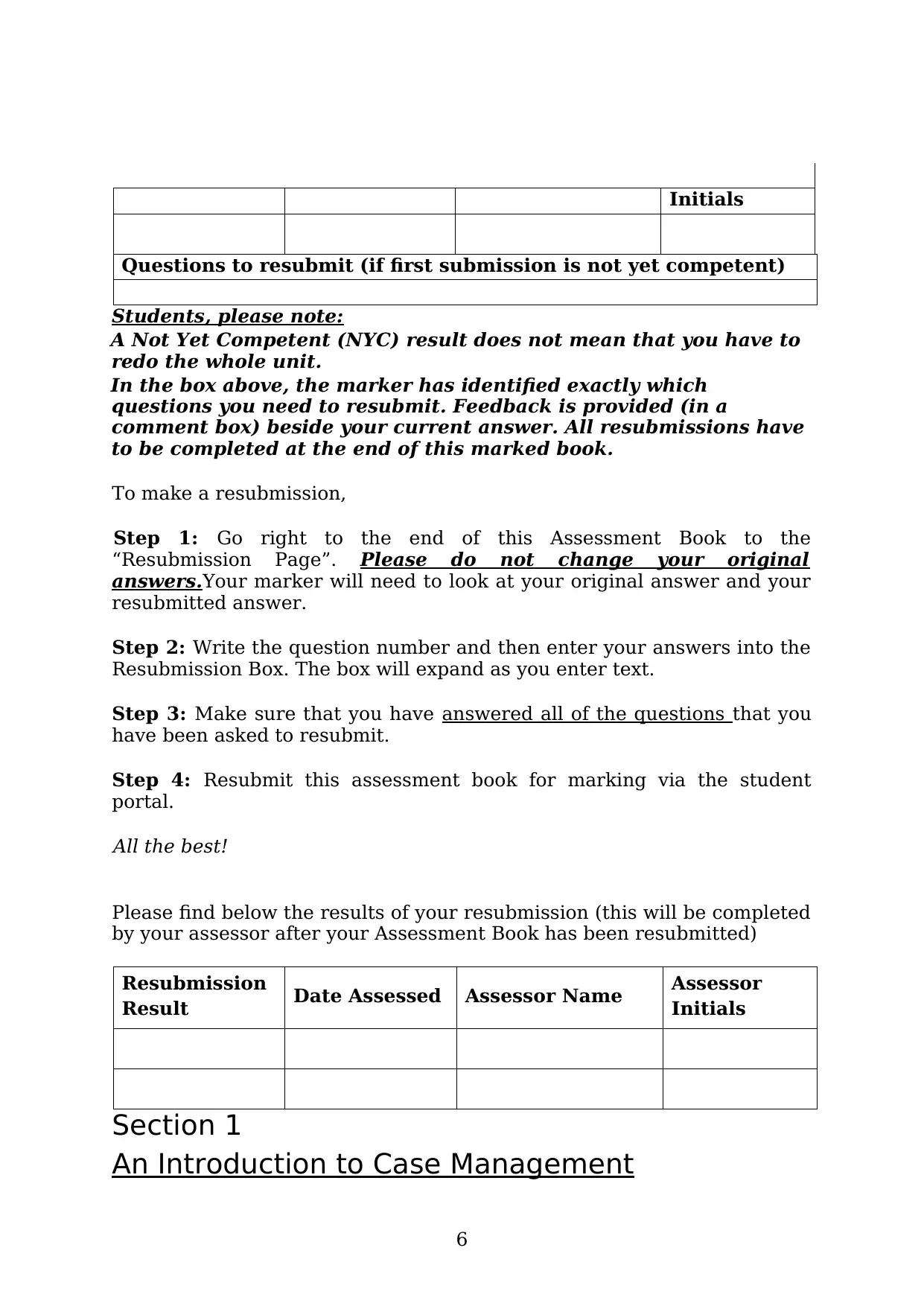
Initials
Questions to resubmit (if first submission is not yet competent)
Students, please note:
A Not Yet Competent (NYC) result does not mean that you have to
redo the whole unit.
In the box above, the marker has identified exactly which
questions you need to resubmit. Feedback is provided (in a
comment box) beside your current answer. All resubmissions have
to be completed at the end of this marked book.
To make a resubmission,
Step 1: Go right to the end of this Assessment Book to the
“Resubmission Page”. Please do not change your original
answers.Your marker will need to look at your original answer and your
resubmitted answer.
Step 2: Write the question number and then enter your answers into the
Resubmission Box. The box will expand as you enter text.
Step 3: Make sure that you have answered all of the questions that you
have been asked to resubmit.
Step 4: Resubmit this assessment book for marking via the student
portal.
All the best!
Please find below the results of your resubmission (this will be completed
by your assessor after your Assessment Book has been resubmitted)
Resubmission
Result Date Assessed Assessor Name Assessor
Initials
Section 1
An Introduction to Case Management
6
Questions to resubmit (if first submission is not yet competent)
Students, please note:
A Not Yet Competent (NYC) result does not mean that you have to
redo the whole unit.
In the box above, the marker has identified exactly which
questions you need to resubmit. Feedback is provided (in a
comment box) beside your current answer. All resubmissions have
to be completed at the end of this marked book.
To make a resubmission,
Step 1: Go right to the end of this Assessment Book to the
“Resubmission Page”. Please do not change your original
answers.Your marker will need to look at your original answer and your
resubmitted answer.
Step 2: Write the question number and then enter your answers into the
Resubmission Box. The box will expand as you enter text.
Step 3: Make sure that you have answered all of the questions that you
have been asked to resubmit.
Step 4: Resubmit this assessment book for marking via the student
portal.
All the best!
Please find below the results of your resubmission (this will be completed
by your assessor after your Assessment Book has been resubmitted)
Resubmission
Result Date Assessed Assessor Name Assessor
Initials
Section 1
An Introduction to Case Management
6
⊘ This is a preview!⊘
Do you want full access?
Subscribe today to unlock all pages.

Trusted by 1+ million students worldwide
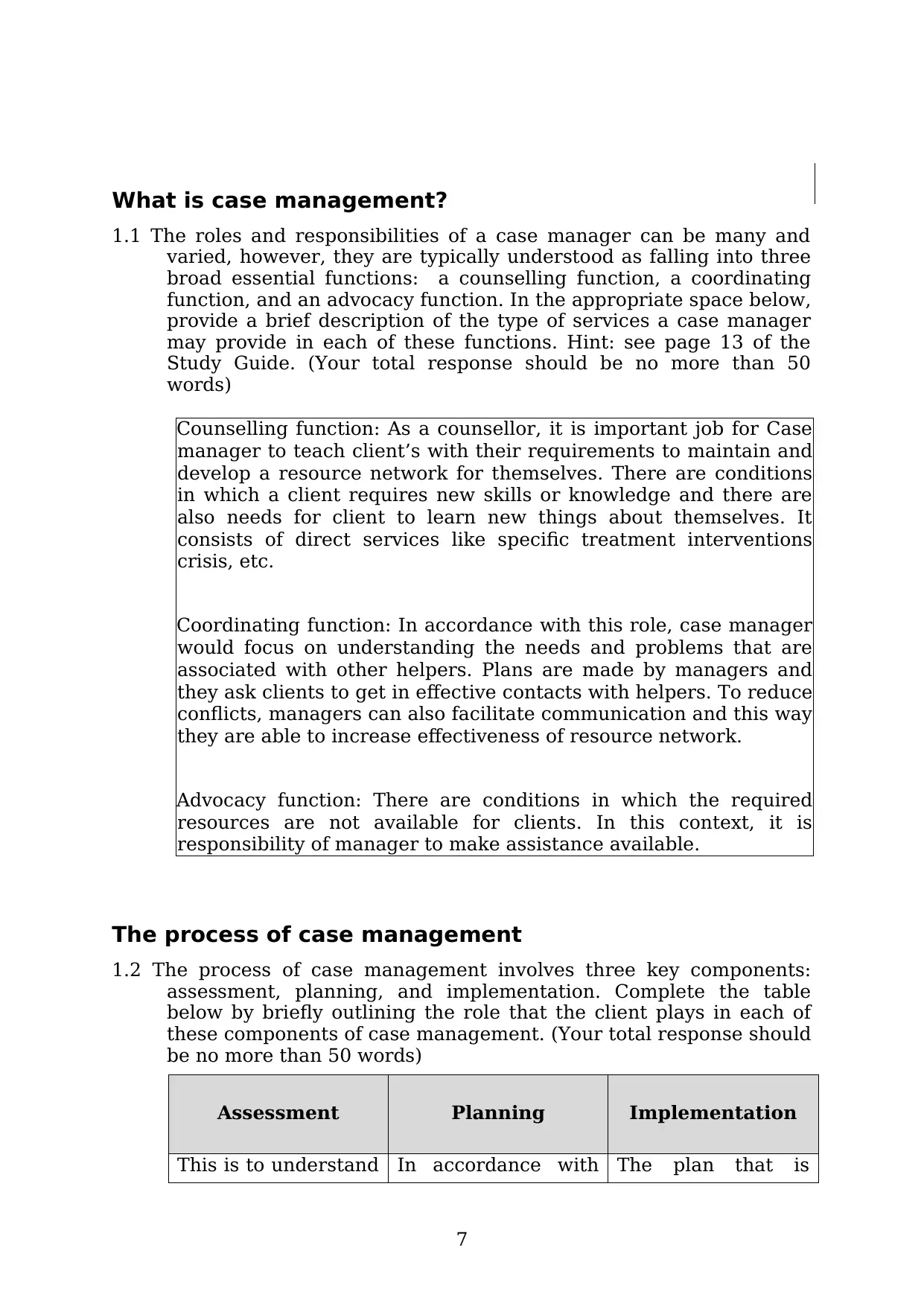
What is case management?
1.1 The roles and responsibilities of a case manager can be many and
varied, however, they are typically understood as falling into three
broad essential functions: a counselling function, a coordinating
function, and an advocacy function. In the appropriate space below,
provide a brief description of the type of services a case manager
may provide in each of these functions. Hint: see page 13 of the
Study Guide. (Your total response should be no more than 50
words)
Counselling function: As a counsellor, it is important job for Case
manager to teach client’s with their requirements to maintain and
develop a resource network for themselves. There are conditions
in which a client requires new skills or knowledge and there are
also needs for client to learn new things about themselves. It
consists of direct services like specific treatment interventions
crisis, etc.
Coordinating function: In accordance with this role, case manager
would focus on understanding the needs and problems that are
associated with other helpers. Plans are made by managers and
they ask clients to get in effective contacts with helpers. To reduce
conflicts, managers can also facilitate communication and this way
they are able to increase effectiveness of resource network.
Advocacy function: There are conditions in which the required
resources are not available for clients. In this context, it is
responsibility of manager to make assistance available.
The process of case management
1.2 The process of case management involves three key components:
assessment, planning, and implementation. Complete the table
below by briefly outlining the role that the client plays in each of
these components of case management. (Your total response should
be no more than 50 words)
Assessment Planning Implementation
This is to understand In accordance with The plan that is
7
1.1 The roles and responsibilities of a case manager can be many and
varied, however, they are typically understood as falling into three
broad essential functions: a counselling function, a coordinating
function, and an advocacy function. In the appropriate space below,
provide a brief description of the type of services a case manager
may provide in each of these functions. Hint: see page 13 of the
Study Guide. (Your total response should be no more than 50
words)
Counselling function: As a counsellor, it is important job for Case
manager to teach client’s with their requirements to maintain and
develop a resource network for themselves. There are conditions
in which a client requires new skills or knowledge and there are
also needs for client to learn new things about themselves. It
consists of direct services like specific treatment interventions
crisis, etc.
Coordinating function: In accordance with this role, case manager
would focus on understanding the needs and problems that are
associated with other helpers. Plans are made by managers and
they ask clients to get in effective contacts with helpers. To reduce
conflicts, managers can also facilitate communication and this way
they are able to increase effectiveness of resource network.
Advocacy function: There are conditions in which the required
resources are not available for clients. In this context, it is
responsibility of manager to make assistance available.
The process of case management
1.2 The process of case management involves three key components:
assessment, planning, and implementation. Complete the table
below by briefly outlining the role that the client plays in each of
these components of case management. (Your total response should
be no more than 50 words)
Assessment Planning Implementation
This is to understand In accordance with The plan that is
7
Paraphrase This Document
Need a fresh take? Get an instant paraphrase of this document with our AI Paraphraser
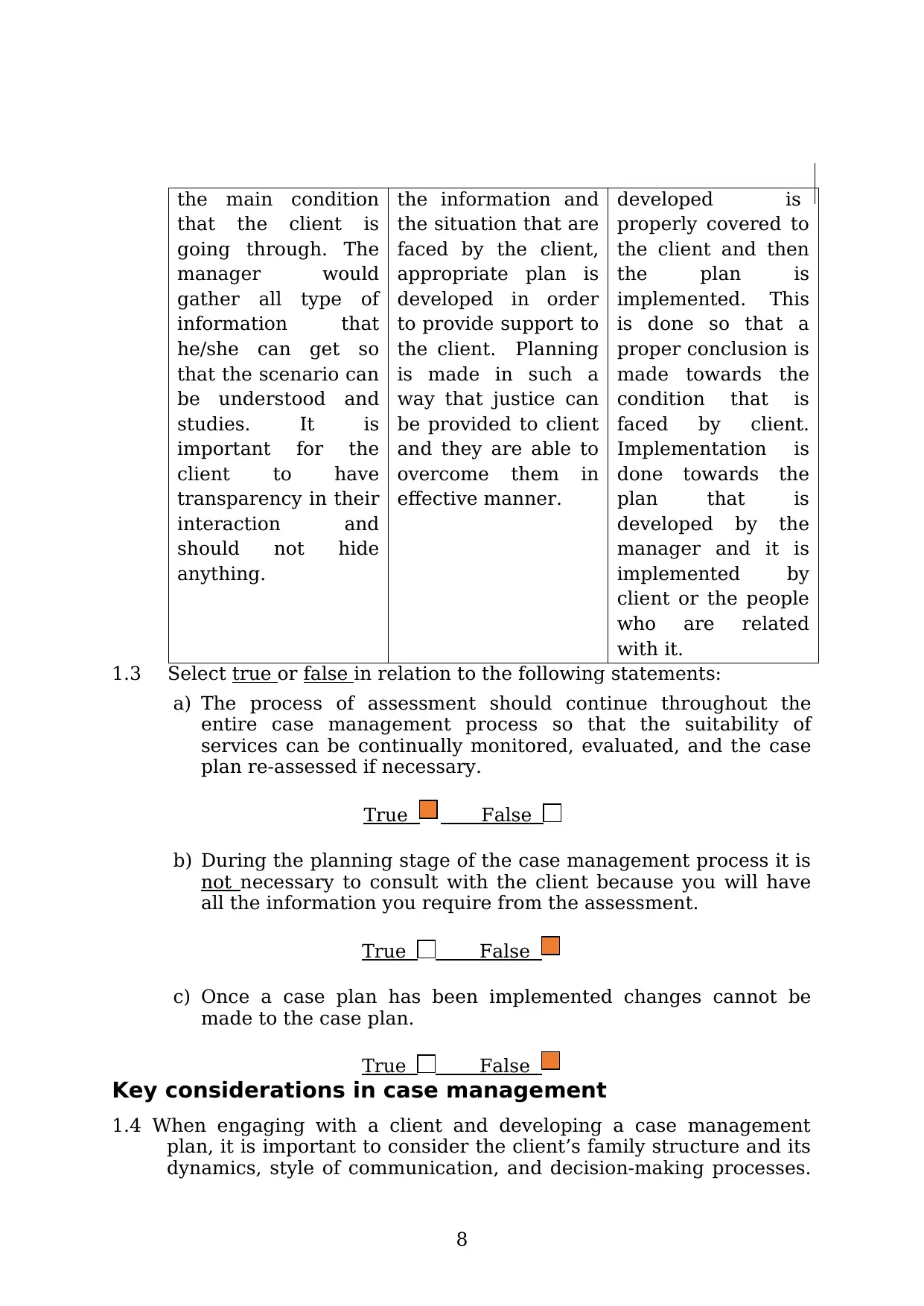
the main condition
that the client is
going through. The
manager would
gather all type of
information that
he/she can get so
that the scenario can
be understood and
studies. It is
important for the
client to have
transparency in their
interaction and
should not hide
anything.
the information and
the situation that are
faced by the client,
appropriate plan is
developed in order
to provide support to
the client. Planning
is made in such a
way that justice can
be provided to client
and they are able to
overcome them in
effective manner.
developed is
properly covered to
the client and then
the plan is
implemented. This
is done so that a
proper conclusion is
made towards the
condition that is
faced by client.
Implementation is
done towards the
plan that is
developed by the
manager and it is
implemented by
client or the people
who are related
with it.
1.3 Select true or false in relation to the following statements:
a) The process of assessment should continue throughout the
entire case management process so that the suitability of
services can be continually monitored, evaluated, and the case
plan re-assessed if necessary.
True False
b) During the planning stage of the case management process it is
not necessary to consult with the client because you will have
all the information you require from the assessment.
True False
c) Once a case plan has been implemented changes cannot be
made to the case plan.
True False
Key considerations in case management
1.4 When engaging with a client and developing a case management
plan, it is important to consider the client’s family structure and its
dynamics, style of communication, and decision-making processes.
8
that the client is
going through. The
manager would
gather all type of
information that
he/she can get so
that the scenario can
be understood and
studies. It is
important for the
client to have
transparency in their
interaction and
should not hide
anything.
the information and
the situation that are
faced by the client,
appropriate plan is
developed in order
to provide support to
the client. Planning
is made in such a
way that justice can
be provided to client
and they are able to
overcome them in
effective manner.
developed is
properly covered to
the client and then
the plan is
implemented. This
is done so that a
proper conclusion is
made towards the
condition that is
faced by client.
Implementation is
done towards the
plan that is
developed by the
manager and it is
implemented by
client or the people
who are related
with it.
1.3 Select true or false in relation to the following statements:
a) The process of assessment should continue throughout the
entire case management process so that the suitability of
services can be continually monitored, evaluated, and the case
plan re-assessed if necessary.
True False
b) During the planning stage of the case management process it is
not necessary to consult with the client because you will have
all the information you require from the assessment.
True False
c) Once a case plan has been implemented changes cannot be
made to the case plan.
True False
Key considerations in case management
1.4 When engaging with a client and developing a case management
plan, it is important to consider the client’s family structure and its
dynamics, style of communication, and decision-making processes.
8
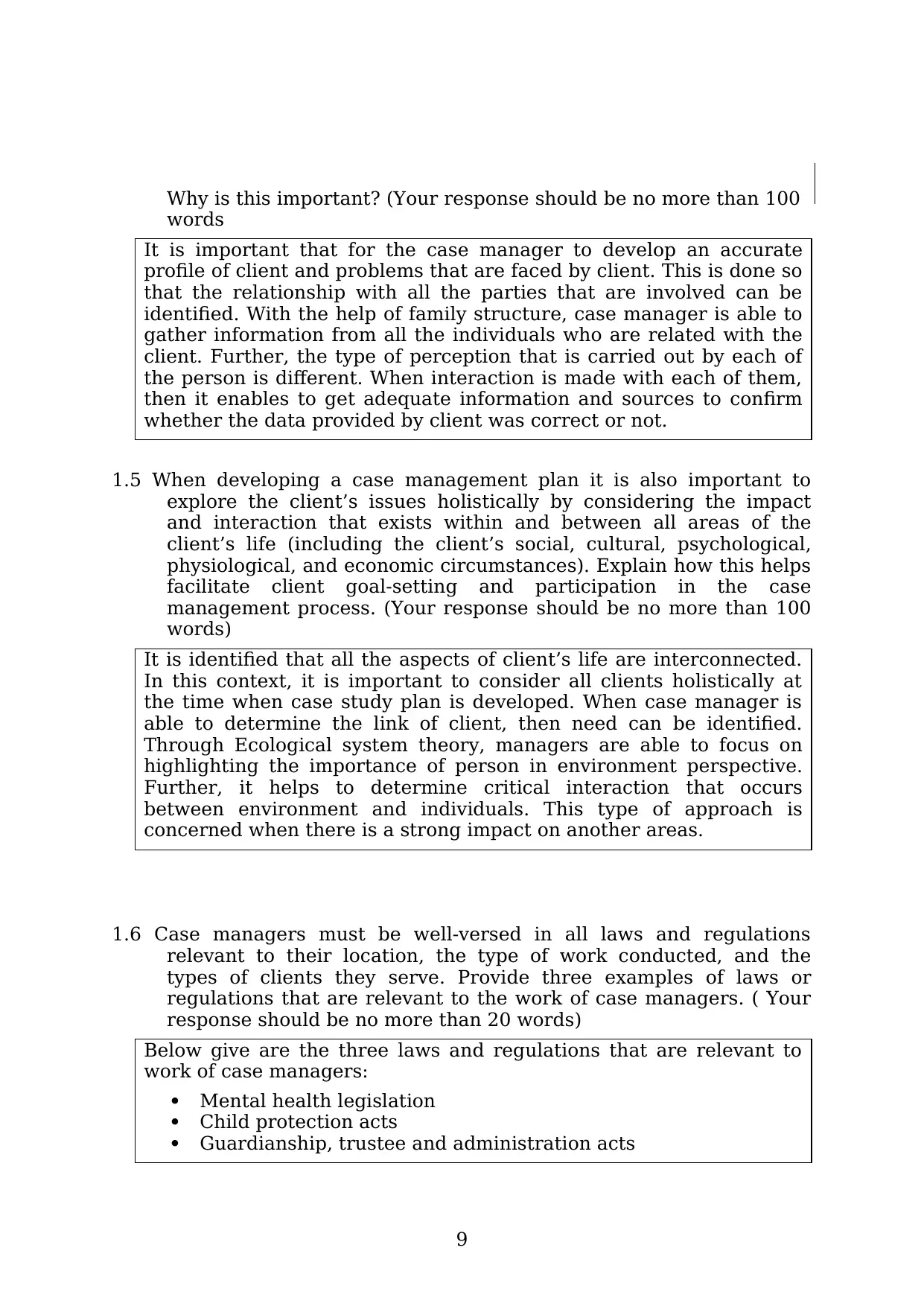
Why is this important? (Your response should be no more than 100
words
It is important that for the case manager to develop an accurate
profile of client and problems that are faced by client. This is done so
that the relationship with all the parties that are involved can be
identified. With the help of family structure, case manager is able to
gather information from all the individuals who are related with the
client. Further, the type of perception that is carried out by each of
the person is different. When interaction is made with each of them,
then it enables to get adequate information and sources to confirm
whether the data provided by client was correct or not.
1.5 When developing a case management plan it is also important to
explore the client’s issues holistically by considering the impact
and interaction that exists within and between all areas of the
client’s life (including the client’s social, cultural, psychological,
physiological, and economic circumstances). Explain how this helps
facilitate client goal-setting and participation in the case
management process. (Your response should be no more than 100
words)
It is identified that all the aspects of client’s life are interconnected.
In this context, it is important to consider all clients holistically at
the time when case study plan is developed. When case manager is
able to determine the link of client, then need can be identified.
Through Ecological system theory, managers are able to focus on
highlighting the importance of person in environment perspective.
Further, it helps to determine critical interaction that occurs
between environment and individuals. This type of approach is
concerned when there is a strong impact on another areas.
1.6 Case managers must be well-versed in all laws and regulations
relevant to their location, the type of work conducted, and the
types of clients they serve. Provide three examples of laws or
regulations that are relevant to the work of case managers. ( Your
response should be no more than 20 words)
Below give are the three laws and regulations that are relevant to
work of case managers:
Mental health legislation
Child protection acts
Guardianship, trustee and administration acts
9
words
It is important that for the case manager to develop an accurate
profile of client and problems that are faced by client. This is done so
that the relationship with all the parties that are involved can be
identified. With the help of family structure, case manager is able to
gather information from all the individuals who are related with the
client. Further, the type of perception that is carried out by each of
the person is different. When interaction is made with each of them,
then it enables to get adequate information and sources to confirm
whether the data provided by client was correct or not.
1.5 When developing a case management plan it is also important to
explore the client’s issues holistically by considering the impact
and interaction that exists within and between all areas of the
client’s life (including the client’s social, cultural, psychological,
physiological, and economic circumstances). Explain how this helps
facilitate client goal-setting and participation in the case
management process. (Your response should be no more than 100
words)
It is identified that all the aspects of client’s life are interconnected.
In this context, it is important to consider all clients holistically at
the time when case study plan is developed. When case manager is
able to determine the link of client, then need can be identified.
Through Ecological system theory, managers are able to focus on
highlighting the importance of person in environment perspective.
Further, it helps to determine critical interaction that occurs
between environment and individuals. This type of approach is
concerned when there is a strong impact on another areas.
1.6 Case managers must be well-versed in all laws and regulations
relevant to their location, the type of work conducted, and the
types of clients they serve. Provide three examples of laws or
regulations that are relevant to the work of case managers. ( Your
response should be no more than 20 words)
Below give are the three laws and regulations that are relevant to
work of case managers:
Mental health legislation
Child protection acts
Guardianship, trustee and administration acts
9
⊘ This is a preview!⊘
Do you want full access?
Subscribe today to unlock all pages.

Trusted by 1+ million students worldwide
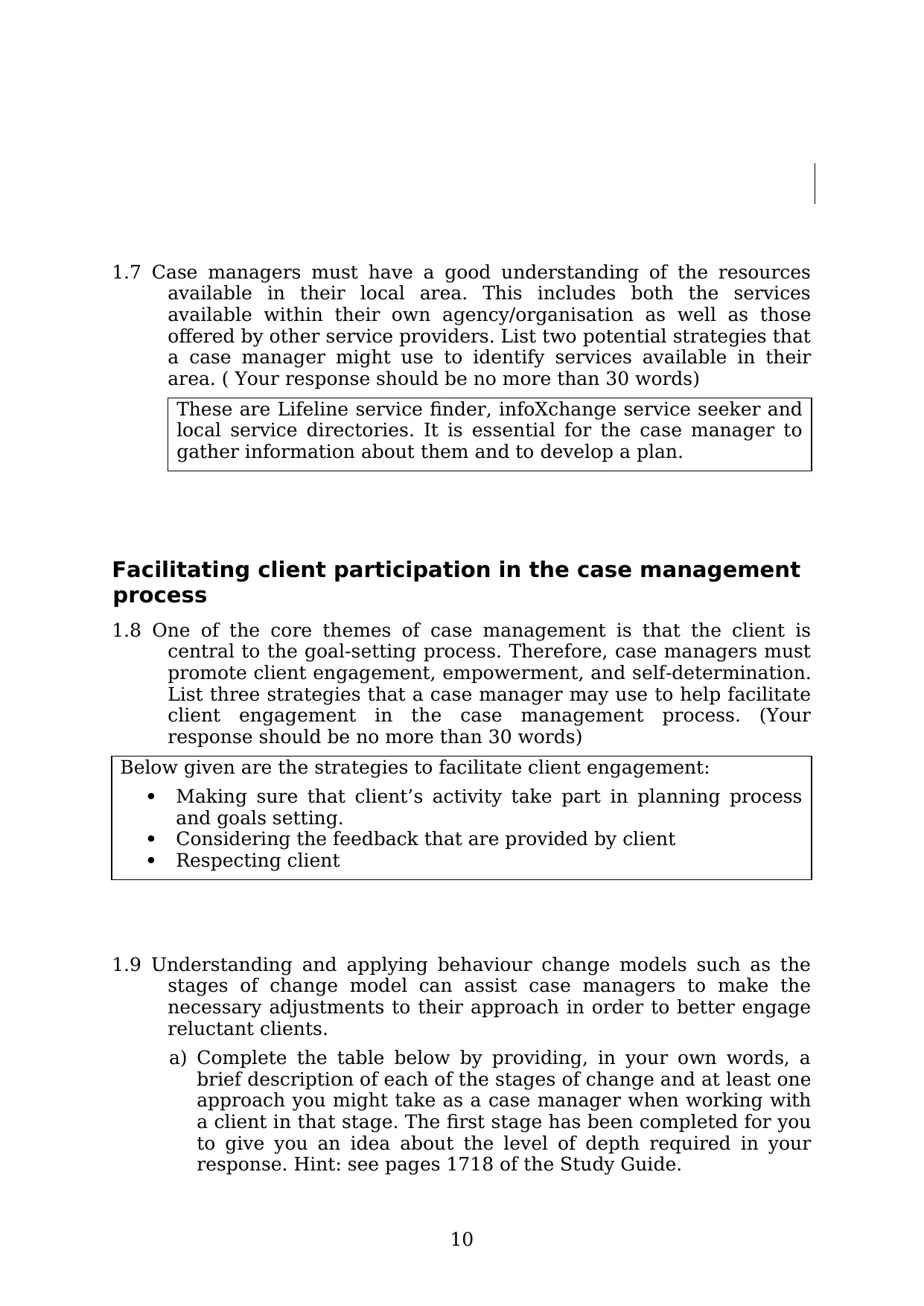
1.7 Case managers must have a good understanding of the resources
available in their local area. This includes both the services
available within their own agency/organisation as well as those
offered by other service providers. List two potential strategies that
a case manager might use to identify services available in their
area. ( Your response should be no more than 30 words)
These are Lifeline service finder, infoXchange service seeker and
local service directories. It is essential for the case manager to
gather information about them and to develop a plan.
Facilitating client participation in the case management
process
1.8 One of the core themes of case management is that the client is
central to the goal-setting process. Therefore, case managers must
promote client engagement, empowerment, and self-determination.
List three strategies that a case manager may use to help facilitate
client engagement in the case management process. (Your
response should be no more than 30 words)
Below given are the strategies to facilitate client engagement:
Making sure that client’s activity take part in planning process
and goals setting.
Considering the feedback that are provided by client
Respecting client
1.9 Understanding and applying behaviour change models such as the
stages of change model can assist case managers to make the
necessary adjustments to their approach in order to better engage
reluctant clients.
a) Complete the table below by providing, in your own words, a
brief description of each of the stages of change and at least one
approach you might take as a case manager when working with
a client in that stage. The first stage has been completed for you
to give you an idea about the level of depth required in your
response. Hint: see pages 1718 of the Study Guide.
10
available in their local area. This includes both the services
available within their own agency/organisation as well as those
offered by other service providers. List two potential strategies that
a case manager might use to identify services available in their
area. ( Your response should be no more than 30 words)
These are Lifeline service finder, infoXchange service seeker and
local service directories. It is essential for the case manager to
gather information about them and to develop a plan.
Facilitating client participation in the case management
process
1.8 One of the core themes of case management is that the client is
central to the goal-setting process. Therefore, case managers must
promote client engagement, empowerment, and self-determination.
List three strategies that a case manager may use to help facilitate
client engagement in the case management process. (Your
response should be no more than 30 words)
Below given are the strategies to facilitate client engagement:
Making sure that client’s activity take part in planning process
and goals setting.
Considering the feedback that are provided by client
Respecting client
1.9 Understanding and applying behaviour change models such as the
stages of change model can assist case managers to make the
necessary adjustments to their approach in order to better engage
reluctant clients.
a) Complete the table below by providing, in your own words, a
brief description of each of the stages of change and at least one
approach you might take as a case manager when working with
a client in that stage. The first stage has been completed for you
to give you an idea about the level of depth required in your
response. Hint: see pages 1718 of the Study Guide.
10
Paraphrase This Document
Need a fresh take? Get an instant paraphrase of this document with our AI Paraphraser
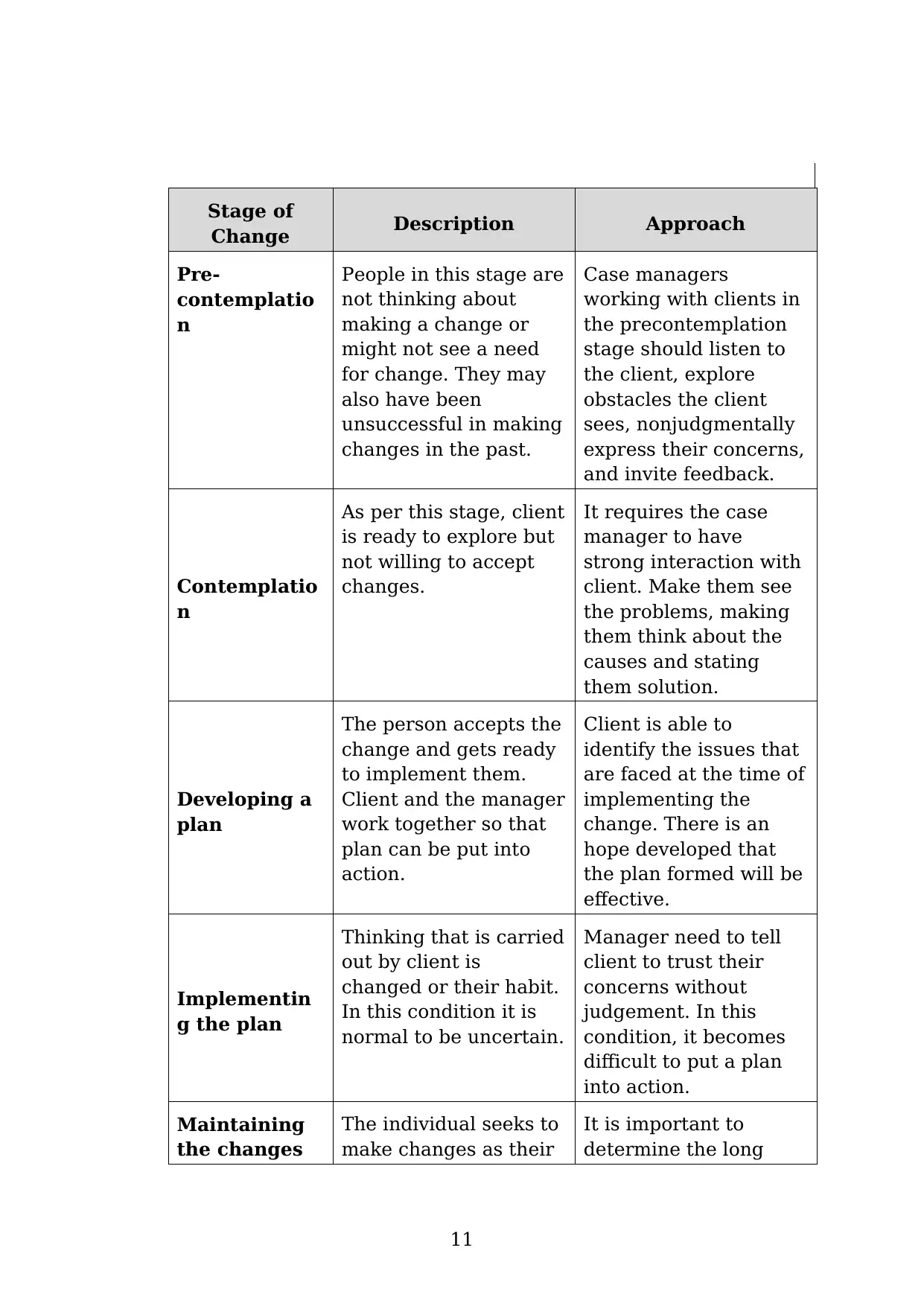
Stage of
Change Description Approach
Pre-
contemplatio
n
People in this stage are
not thinking about
making a change or
might not see a need
for change. They may
also have been
unsuccessful in making
changes in the past.
Case managers
working with clients in
the precontemplation
stage should listen to
the client, explore
obstacles the client
sees, nonjudgmentally
express their concerns,
and invite feedback.
Contemplatio
n
As per this stage, client
is ready to explore but
not willing to accept
changes.
It requires the case
manager to have
strong interaction with
client. Make them see
the problems, making
them think about the
causes and stating
them solution.
Developing a
plan
The person accepts the
change and gets ready
to implement them.
Client and the manager
work together so that
plan can be put into
action.
Client is able to
identify the issues that
are faced at the time of
implementing the
change. There is an
hope developed that
the plan formed will be
effective.
Implementin
g the plan
Thinking that is carried
out by client is
changed or their habit.
In this condition it is
normal to be uncertain.
Manager need to tell
client to trust their
concerns without
judgement. In this
condition, it becomes
difficult to put a plan
into action.
Maintaining
the changes
The individual seeks to
make changes as their
It is important to
determine the long
11
Change Description Approach
Pre-
contemplatio
n
People in this stage are
not thinking about
making a change or
might not see a need
for change. They may
also have been
unsuccessful in making
changes in the past.
Case managers
working with clients in
the precontemplation
stage should listen to
the client, explore
obstacles the client
sees, nonjudgmentally
express their concerns,
and invite feedback.
Contemplatio
n
As per this stage, client
is ready to explore but
not willing to accept
changes.
It requires the case
manager to have
strong interaction with
client. Make them see
the problems, making
them think about the
causes and stating
them solution.
Developing a
plan
The person accepts the
change and gets ready
to implement them.
Client and the manager
work together so that
plan can be put into
action.
Client is able to
identify the issues that
are faced at the time of
implementing the
change. There is an
hope developed that
the plan formed will be
effective.
Implementin
g the plan
Thinking that is carried
out by client is
changed or their habit.
In this condition it is
normal to be uncertain.
Manager need to tell
client to trust their
concerns without
judgement. In this
condition, it becomes
difficult to put a plan
into action.
Maintaining
the changes
The individual seeks to
make changes as their
It is important to
determine the long
11
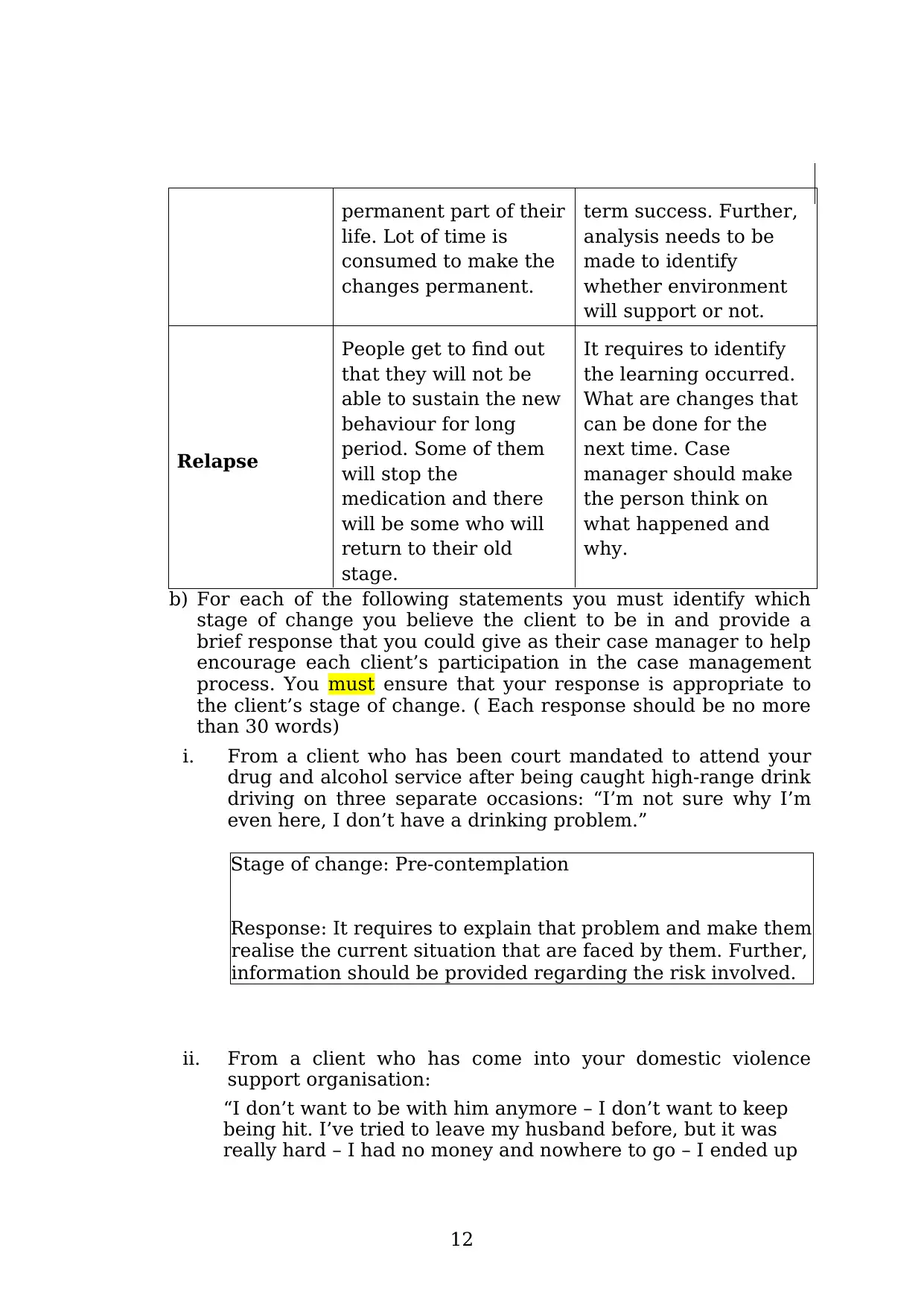
permanent part of their
life. Lot of time is
consumed to make the
changes permanent.
term success. Further,
analysis needs to be
made to identify
whether environment
will support or not.
Relapse
People get to find out
that they will not be
able to sustain the new
behaviour for long
period. Some of them
will stop the
medication and there
will be some who will
return to their old
stage.
It requires to identify
the learning occurred.
What are changes that
can be done for the
next time. Case
manager should make
the person think on
what happened and
why.
b) For each of the following statements you must identify which
stage of change you believe the client to be in and provide a
brief response that you could give as their case manager to help
encourage each client’s participation in the case management
process. You must ensure that your response is appropriate to
the client’s stage of change. ( Each response should be no more
than 30 words)
i. From a client who has been court mandated to attend your
drug and alcohol service after being caught high-range drink
driving on three separate occasions: “I’m not sure why I’m
even here, I don’t have a drinking problem.”
Stage of change: Pre-contemplation
Response: It requires to explain that problem and make them
realise the current situation that are faced by them. Further,
information should be provided regarding the risk involved.
ii. From a client who has come into your domestic violence
support organisation:
“I don’t want to be with him anymore – I don’t want to keep
being hit. I’ve tried to leave my husband before, but it was
really hard – I had no money and nowhere to go – I ended up
12
life. Lot of time is
consumed to make the
changes permanent.
term success. Further,
analysis needs to be
made to identify
whether environment
will support or not.
Relapse
People get to find out
that they will not be
able to sustain the new
behaviour for long
period. Some of them
will stop the
medication and there
will be some who will
return to their old
stage.
It requires to identify
the learning occurred.
What are changes that
can be done for the
next time. Case
manager should make
the person think on
what happened and
why.
b) For each of the following statements you must identify which
stage of change you believe the client to be in and provide a
brief response that you could give as their case manager to help
encourage each client’s participation in the case management
process. You must ensure that your response is appropriate to
the client’s stage of change. ( Each response should be no more
than 30 words)
i. From a client who has been court mandated to attend your
drug and alcohol service after being caught high-range drink
driving on three separate occasions: “I’m not sure why I’m
even here, I don’t have a drinking problem.”
Stage of change: Pre-contemplation
Response: It requires to explain that problem and make them
realise the current situation that are faced by them. Further,
information should be provided regarding the risk involved.
ii. From a client who has come into your domestic violence
support organisation:
“I don’t want to be with him anymore – I don’t want to keep
being hit. I’ve tried to leave my husband before, but it was
really hard – I had no money and nowhere to go – I ended up
12
⊘ This is a preview!⊘
Do you want full access?
Subscribe today to unlock all pages.

Trusted by 1+ million students worldwide
1 out of 54
Related Documents
Your All-in-One AI-Powered Toolkit for Academic Success.
+13062052269
info@desklib.com
Available 24*7 on WhatsApp / Email
![[object Object]](/_next/static/media/star-bottom.7253800d.svg)
Unlock your academic potential
Copyright © 2020–2025 A2Z Services. All Rights Reserved. Developed and managed by ZUCOL.





